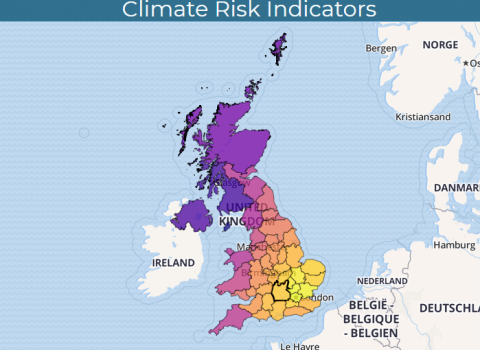COP26 has so far focused on reducing emissions of greenhouse gases. But we also need to adapt to a changing climate and increase our resilience to risks. One of the barriers to this is a lack of information on how risks might change at the local scale, in terms directly relevant to users.
The University of Reading has therefore launched a new website showing how climate change will affect different risks in every corner of the UK.
The UK Climate Risk Indicators project website users to see how extreme temperatures, droughts, river floods and wildfire will affect risks in their local area and at the national scale The estimates are available for different time periods up to the end of the century and for different assumptions about how greenhouse gas emissions change. They are presented using accessible maps and graphs.
Research underpinning the data on the website was undertaken as part of the UK Climate Resilience Programme funded by UK Research and Innovation and the Met Office
The free-to-use website is aimed at agencies and decisionmakers responsible for helping the UK adapt to and prepare for climate risks to communities, transport, infrastructure, buildings and agriculture. How might growing seasons change, for example, and what is the chance of getting temperatures high enough to melt roads?
The launch of the tool was announced at an event, “Building climate resilience in a low carbon world”, at the Science Pavilion at COP26 on 10 November, co-hosted by the UK Climate Resilience Programme and Future Climate for Africa.
Professor Nigel Arnell, Professor of Climate Change Science at the University of Reading, said: “There is a wealth of research and data on how the world is likely to be affected by climate change, so the key challenge is getting that information to those that need it in an easy-to-use way.
“This website provides a comprehensive tool that can be used to inform decisions on everything from infrastructure development to housebuilding and healthcare.”
The website allows users to look at 39 separate climate impacts across seven categories: Climate, Temperature Extremes, Heating and Cooling, Transport, Agriculture, Wildfire and Water. The indicators are calculated at scales ranging from the smallest local authority to the four nations of the UK.
Users can combine impacts and create maps based on the different indicators and download time series for specific locations.
The research was led by Professor Arnell and at the UK Centre for Ecology and Hydrology, while the website was developed by the Institute for Environmental Analytics based at the University of Reading.

